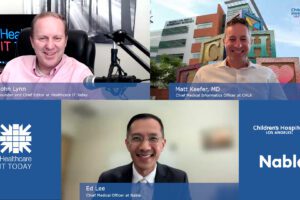Implementing diversity, equity, and inclusion (DE&I) initiatives and addressing the workforce challenge in healthcare are not mutually exclusive. In fact, improving DE&I may be one of the quickest ways to alleviate the pressure of finding and keeping healthcare talent. How? Indigenous groups, visible minorities, and women are underutilized talent pools. With encouragement and training they could be a great source of healthcare staff.
Shanil Ebrahim, a Partner and the National Life Sciences & Healthcare Consulting Leader at Deloitte Canada, is a firm believer that strategies designed to improve the diversity of healthcare workforces will ultimately lead to better outcomes for patients, more pools of talent, and stronger relationships between healthcare organizations and the communities they serve.
Healthcare IT Today had the opportunity to do a deep dive into DE&I and healthcare’s workforce challenge with Ebrahim.
Importance of DE&I in Healthcare
A study conducted by the Commonwealth Fund, found that patient satisfaction and health outcomes improve when healthcare providers and their patients “have concordance in their racial, ethnic, and language backgrounds.” Stated simply, patients feel better cared for when someone with the same cultural context and who can speak in their primary language is part of their care team.
More recently, Deloitte published the results of their research on healthcare executives’ perspectives on health equity. They found that executives see:
- The strong connection between diversity and inclusion in their workforce and improved health equity outcomes in patients
- That improving DE&I in their workforce can support quality of care and financial performance goals
- Addressing racism and other biases can be a competitive advantage
“A diverse, inclusive workforce that looks and feels like the community the healthcare provider is serving can help improve trust, empathy, and strengthen the connection with that community,” said Ebrahim.
DE&I vs the Workforce Challenge
The inability to find and keep both clinical as well as non-clinical staff has strained healthcare organizations around the world. Doctors, nurses, technicians, revenue cycle specialists, cybersecurity experts, and even HR staff are in short supply. Job postings remain open for weeks, sometimes even months as organizations search far and wide for qualified candidates.
In light of this challenge, healthcare leaders could be excused for deprioritizing DE&I initiatives, but Ebrahim believes otherwise.
“It might be logical to think that looking for a diverse workforce when there is a labor shortage will hamper an organization,” stated Ebrahim. “In fact, the better question to ask is why there is a shortage of labor in the first place. Once you understand that, suddenly DE&I becomes the solution rather than a distraction.”
Craig Alexander, Chief Economist and Executive Advisor at Deloitte Canada, wrote a fantastic article that identified the drivers of the labor shortage. Alexander and the team at Deloitte found that:
- Shortages were related to geography, industry, occupation, and skill mismatches
- There was a significant decline in labor participation in workers aged 55+, likely due to retirement
- Structural factors influence shortages like an aging domestic population, reliance on immigration for net labor force growth, and underutilized domestic pools of labor
It is the last finding where Ebrahim sees the opportunity for DE&I initiatives to help.
“DE&I can actually help address the workforce challenges,” said Ebrahim. “One way to solve for the shortage is to tap into underutilized pools of talent – immigrants, indigenous people, visible minorities, women, and people with disabilities. DE&I initiatives, by their very nature, are designed to draw from these groups.”
The bottom line: it is not improving DE&I or addressing the workforce challenge. It is improving DE&I and addressing the workforce challenge.
Building a Talent Pipeline
Unfortunately, it is not as simple as targeting recruiters at visible minorities, indigenous groups, etc. Part of the reason why these groups are underutilized and under-represented in the healthcare workforce is because they lack the skills to fill the open roles. Ebrahim believes this skills gap could be addressed in the short-term if proper funding and skills programming are put in place immediately.
“We need to focus on building a talent pipeline that will meet the future needs of healthcare – clinical and non-clinical,” said Ebrahim. “This means healthcare providers need to partner with local educational institutions and community organizations to build the programs needed to retrain individuals from these underutilized groups.”
To be clear, Ebrahim is not referring to doctors or nurses. Rather he is thinking about personal support workers, case managers, revenue cycle experts, etc. Those are skills that can be acquired in a much shorter time.
Unconventional Partnerships
During our interview Ebrahim strongly suggested that healthcare providers look at forging unconventional partnerships as a way to immediately alleviate labor shortages.
“Let’s be honest, healthcare is not a magnet for tech talent,” explained Ebrahim. “Instead, healthcare leaders should look to where there is a concentration of good talent and then forge a partnership with organizations that are. For example, why not work with a professional services or consulting firm, or a cybersecurity company to leverage their workforce to augment your own.”
As the economy turns, technology companies are starting to downsize their workforce. Although some of these talented individuals may end up in healthcare, the majority will land opportunities in other industries. What Ebrahim is suggesting is for healthcare organizations to approach tech companies ahead of potential layoffs, have them keep their staff, and work out a contract whereby their team can work on projects for the healthcare organization.
“The value proposition is this: You [the company] continue to attract and nurture the tech talent and we [the healthcare organization] can offer a place for those talented individuals to apply their skills in a way that benefits patients and by extension the broader community,” continued Ebrahim.
Watch the interview with Shanil Ebrahim to learn:
- Tips on how to sustain DE&I initiatives in tough times
- 4 key characteristics of successful DE&I initiatives
- How to build and measure a healthcare talent pipeline
- How technology can accelerate or enhance healthcare DE&I initiatives
- Why companies like SAP, Qualtrics, and Workday might be worth a look
Learn more about Deloitte Canada at: https://www2.deloitte.com/ca/en/pages/about-deloitte/articles/home.html
Listen and subscribe to the Healthcare IT Today Interviews Podcast to hear all the latest insights from experts in healthcare IT.
And for an exclusive look at our top stories, subscribe to our newsletter.
Tell us what you think. Contact us here or on Twitter at @hcitoday. And if you’re interested in advertising with us, check out our various advertising packages and request our Media Kit.
Deloitte Canada is a supporter of Healthcare Scene.













